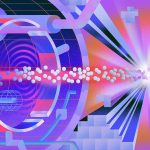From University of Birmingham, Jan. 13, 2021: Fermilab will take part in an international collaboration, led by Cardiff University, on quantum-enhanced interferometry for new physics. The project’s four table-top experiments may help explore new parameter spaces of photon-dark matter interaction, and seek answers to the long-standing question at the heart of modern science: How can gravity be united with the other fundamental forces?
Author Archive
From Mission Unstoppable, Jan. 26, 2021: Fermilab scientist Jessica Esquivel explains how light particles work with makeup to create a look.
From Yale University, Jan. 22, 2021: For his new piece of music, “MicroBooNE,” David Ibbett, Fermilab’s first composer-in-residence, collaborated with physics professor Bonnie Fleming through a series of discussions about the science behind the experiment that inspired the composition. The neutrino-inspired piece premiered on Dec. 8, 2020, as part of the Fermilab Arts and Lectures Series.
From University of Strathclyde-Glasgow, Jan. 13, 2021: Fermilab will take part in an international collaboration, led by Cardiff University, on quantum-enhanced interferometry for new physics. The project’s four table-top experiments may help explore new parameter spaces of photon-dark matter interaction, and seek answers to the long-standing question at the heart of modern science: How can gravity be united with the other fundamental forces?
From New Scientist, Jan. 25, 2021: The Big Bang left us the universe — and a major set of mysteries around antimatter, dark matter, dark energy, and cosmic inflation. While the Large Hadron Collider looks at what the laws of physics were like a trillionth of a second after the Big Bang, Dan Hooper, head of theoretical astrophysics at Fermilab, thinks the answers to these puzzles may depend on better understanding that first fraction of a second — even closer to the universe’s beginning.
From Big Think, Jan. 10, 2021: The quantum breakthrough Fermilab and its partners made in teleporting qubits over a fiber-optic network more than 27 miles highlights how close — and how far — modern science is from sci fi.
From University of Glasgow, Jan. 13, 2021: Fermilab will take part in an international collaboration, led by Cardiff University, on quantum-enhanced interferometry for new physics. The project’s four table-top experiments may help explore new parameter spaces of photon-dark matter interaction, and seek answers to the long-standing question at the heart of modern science: How can gravity be united with the other fundamental forces?
From CERN, Jan. 26, 2021: This week marks the 50th anniversary of the first proton collisions in CERN’s Intersecting Storage Rings, the first hadron collider ever built. To celebrate, see hadron colliders of the last half-century — including the Tevatron and the Large Hadron Collider — through a historical lens, with an eye toward the quest for high luminosity and new energy frontiers.
From Mashable, Jan. 19, 2021: In a huge breakthrough, a team of researchers from Caltech, Fermilab, AT&T, Harvard, NASA and the University of Calgary teleported quantum information over a fiber-optic network of 44 kilometers. This video shares how high-fidelity quantum teleportation lays the groundwork for a functional quantum internet, making the internet faster and more secure, and its technological and societal implications.

